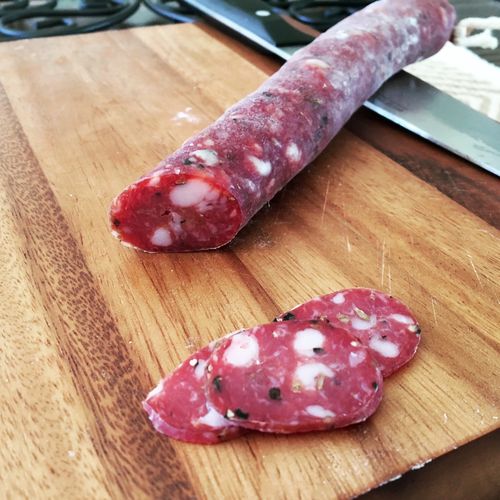Popular on Food52
20 Comments
frank C.
December 15, 2017
did you dice or grind your meat in the above picture? I see that the fat was cubed
Andreas D.
April 7, 2016
If this all sounds a little intimidating, may I recommend Michael Ruhlman's book "Charcuterie: The Craft Of Salting Smoking And Curing".
Getting into the craft is actually really simple: Buy a duck breast, cure it in alt and spices, hang it to dry somewhere in your basement - two weeks later, duck prosciutto.
I've been curing bacon and pancetta for years in my house, with no more tools than a bit of string and a nail to hang it from.
Getting into the craft is actually really simple: Buy a duck breast, cure it in alt and spices, hang it to dry somewhere in your basement - two weeks later, duck prosciutto.
I've been curing bacon and pancetta for years in my house, with no more tools than a bit of string and a nail to hang it from.
Lizzie G.
April 7, 2016
Hi Andreas,
Yes, we actually started the same way! Duck prosciutto is so good. We're currently doing our first bacon right now. One day I'd love to be able to do a real pig prosciutto but I'm still mastering the small stuff first. Thanks for the recommendation on the book! i will check that one out.
Yes, we actually started the same way! Duck prosciutto is so good. We're currently doing our first bacon right now. One day I'd love to be able to do a real pig prosciutto but I'm still mastering the small stuff first. Thanks for the recommendation on the book! i will check that one out.
celiaruthless
April 6, 2016
Pro tip from another would-be charcuterie-maker who has accidentally released ozone-unfriendly gases into our atmosphere: Google your mini-fridge model and look up a product manual to find and avoid Freon lines. Also, computer fans are great for ventilation and a mini desk humidifier can provide necessary moisture.
Lizzie G.
April 6, 2016
Thanks for the tip ArcheaoCook!
On our third go-round we did look up the product schematic but unfortunately it did not include the location of the gas lines. (Or we were bad at reading it) What we did do though, (got this idea from a home brewing thread) was cut out a plastic hole on the inside of the fridge and then gently dig out the foam insulation Shawshank Redemption style to ensure there was no gas line before ultimately drilling out through the external metal layer of the fridge. Voila! Almost all fridge's freon lines run run against the outside metal wall of the fridge so this method greatly reduces risk.
We also used a computer fan for ventilation with great success!
On our third go-round we did look up the product schematic but unfortunately it did not include the location of the gas lines. (Or we were bad at reading it) What we did do though, (got this idea from a home brewing thread) was cut out a plastic hole on the inside of the fridge and then gently dig out the foam insulation Shawshank Redemption style to ensure there was no gas line before ultimately drilling out through the external metal layer of the fridge. Voila! Almost all fridge's freon lines run run against the outside metal wall of the fridge so this method greatly reduces risk.
We also used a computer fan for ventilation with great success!
Aileen
April 6, 2016
"With this pearl of wisdom, one successful Craigslist deal, and three hours of trying to get Fridge #2 into our basement, we struck out on our journey towards spicy meat snacks." This baseball metaphor is a little... off. Was the second fridge successful? It doesn't sound like it...
Lizzie G.
April 6, 2016
Hi Aileen,
Sorry for the confusion! That was not meant to be a baseball metaphor. Yes, we were successful on our second journey.
Sorry for the confusion! That was not meant to be a baseball metaphor. Yes, we were successful on our second journey.
José R.
April 6, 2016
You look like you're not aware that nitrites convert in our bodies to nitrosamines which are strong carcinogens, one of the causes of cancer cured meat lovers get.
Lizzie G.
April 6, 2016
Thanks for bringing up an important topic Jose. Excessive intake of nitrites may be linked to cancer. Luckily, the nitrites included in cured meat and sausage is enough to prevent botulism, but not nearly enough to be carcinogenic. While I would never try to convince anyone to eat something that they or their doctor isn't comfortable with, vegetables like spinach, celery and radishes naturally contain far more nitrites than cured meat does.
Andreas D.
April 7, 2016
Celery especially. That's why food producers use celery to cure meats and can still claim "no nitrites" on the label.
José R.
April 10, 2016
Lizzie, There’s not «excessive» nitrites intake. There is or there is not. Nitrites convert to nitrosamines which are carcinogenic. Studies show that cured meat is strongly associated with cancer but not celery or radish or spinach. True, historically nitrites prevented botulism, but nowadays we know more. I love sausages specially the well prepared so I chose without Sodium Nitrites which I fortunately find in my select provider in many variations here in Montreal, Canada.
Andreas D.
April 10, 2016
José, that is incorrect. If you are eating cured meats, you're consuming nitrites, whether they appear on the label or not. As you're in Montreal, I chose an article published by McGill that explains the details: http://blogs.mcgill.ca/oss/2013/04/04/is-celery-juice-a-viable-alternative-to-nitrites-in-cured-meats/
José R.
April 11, 2016
What’s incorrect? Processed meats are manufactured using sodium nitrite. A study by the Cancer Research Center of Hawaii and the University of Southern California suggests a link between eating processed meats and cancer risk. The study followed 190,000 people, ages 45-75, for seven years and found that people who ate the most processed meats had a 67% higher risk of pancreatic cancer than those who ate the least amount.
Mike C.
April 5, 2016
How did you modify your fridge? And how do you control the humidity?
Lizzie G.
April 6, 2016
Thanks for the question Mike!
The two major steps for converting your fridge is to invest in a temperature controller that will allow your fridge to maintain a temperature above it's normal range (32-40F). You can purchase one here: http://www.amazon.com/dp/B0002EAL58?tag=wrightfood-20&camp=14573&creative=327641&linkCode=as1&creativeASIN=B0002EAL58&adid=10456JWVX52RVYXDN1MK&
The other step is control humidity. You can do this by purchasing a cheap humidifier (we prefer an ultrasonic model) and buying a humidifier controller that will allow your humidifier to turn on and off to maintain the steady relative humidity level that you want. You can buy one here: http://www.amazon.com/gp/product/B001OLVNUK?ie=UTF8&tag=wrightfood-20&linkCode=as2&camp=1789&creative=9325&creativeASIN=B001OLVNUK
On the web, both http://mattikaarts.com/blog/meat-curing-at-home-the-setup/ and http://benstarr.com/blog/how-to-convert-a-refrigerator-for-curing-meat-or-aging-cheese/ are very good resources we used for guidance when we converted our fridge.
The two major steps for converting your fridge is to invest in a temperature controller that will allow your fridge to maintain a temperature above it's normal range (32-40F). You can purchase one here: http://www.amazon.com/dp/B0002EAL58?tag=wrightfood-20&camp=14573&creative=327641&linkCode=as1&creativeASIN=B0002EAL58&adid=10456JWVX52RVYXDN1MK&
The other step is control humidity. You can do this by purchasing a cheap humidifier (we prefer an ultrasonic model) and buying a humidifier controller that will allow your humidifier to turn on and off to maintain the steady relative humidity level that you want. You can buy one here: http://www.amazon.com/gp/product/B001OLVNUK?ie=UTF8&tag=wrightfood-20&linkCode=as2&camp=1789&creative=9325&creativeASIN=B001OLVNUK
On the web, both http://mattikaarts.com/blog/meat-curing-at-home-the-setup/ and http://benstarr.com/blog/how-to-convert-a-refrigerator-for-curing-meat-or-aging-cheese/ are very good resources we used for guidance when we converted our fridge.












Join The Conversation